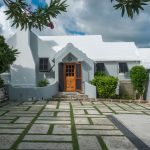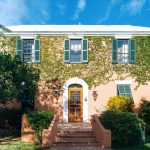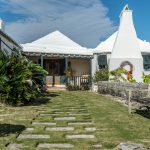Floral inspirations & architectural ingenuity
We don’t often use personifying words to define the architectural styles seen around the world. However, in Bermuda where homes are described as charming and full of character, it comes as no surprise that we have ‘decorative eyebrows’ over our windows and ‘welcoming arms’ entrances. But where did these classic Bermudian architectural quirks originate from?
Hurricanes have played a significant role in the evolution of the Bermuda-style home. In the early 1600’s – when the island was first colonized – cedar was the material of choice for the construction of buildings, and their roofs were made from thatched palmetto fronds. However, by the end of the 17th century, Bermudian houses were built from limestone, a material more suited to withstand the harsh environmental conditions of a sub-tropical island. The use of limestone was a trend that carried on for over 350 years. Nowadays, newly constructed Bermudian homes are built using concrete block, due to the growing scarcity of limestone.
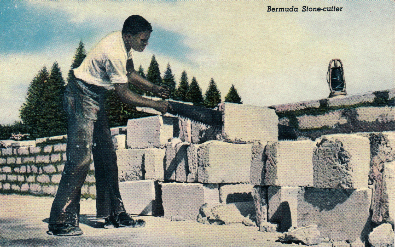
A Bermudian stone cutter (Tools & Trades History Society)
The stepped white roof is quintessentially Bermudian. Slates of limestone are placed over a wood frame, held together by mortar and then ‘white-washed’. The stepped roof is capable of withstanding gale-force winds and provides a workaround to the issue of Bermuda having no natural source of fresh water. This innovative design, built with efficiency in mind, allows for rainwater to be directed from the roof into a water catchment tank, often found underneath the house. These white roofs are also responsible for creating the classic Bermudian landscape, along with our pastel buildings and palm trees.
It became a trend to use the same limewash that was applied to Bermudian roofs on the exterior walls of our buildings. Initially, Bermuda’s distinctive colour palette mimicked that of the island’s native flora – often delicate hues of purple, pink and yellow. In recent years Bermudians have gravitated to painting their homes with brighter and bolder colours, but our more traditional houses are still adorned with the floral tones of the past.
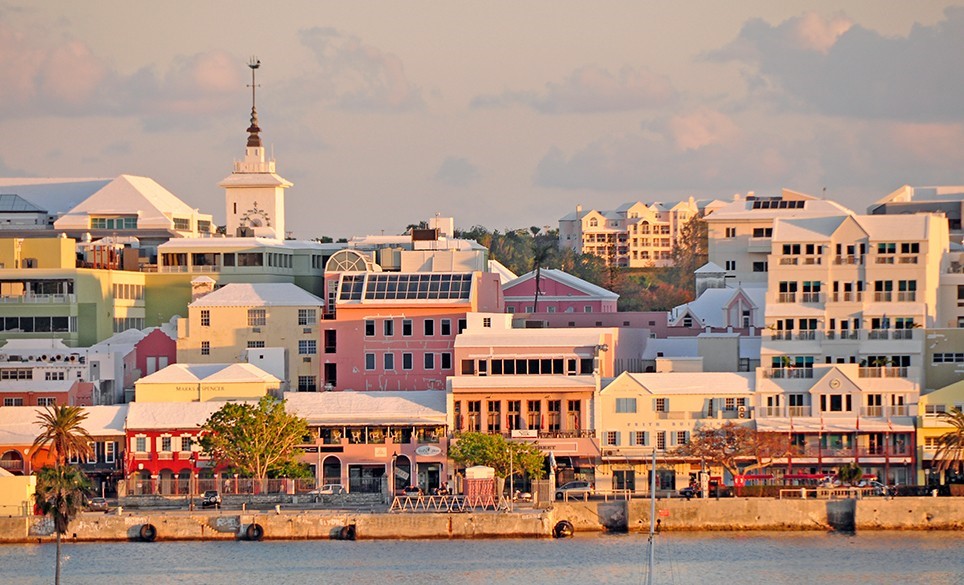
City of Hamilton (Bermuda Tourism)
The decorative touches that have come to be recognized as classically Bermudian include wrap around verandas, top-hung shutters, cedar-trimmed windows and ‘welcoming arms’ entrances – staircases with graceful walls that narrowed leading up to the front door. One of Bermuda’s most recognized, and most influential architects of the 20th century, Wil Onions, was largely responsible for bringing back the ‘classic’ Bermudian style.
- Old Battery
- Longford House
- Grey Gables
Concern arose in the late 1930’s from the loss of important examples of Bermudian architecture and as a result, the Bermuda Historical Monuments Trust – now the Bermuda National Trust – was created. Their mission is to protect and preserve Bermuda’s cultural heritage and presently cares for 82 properties across the island. In 2000, the town of St. George was named a UNESCO world heritage site on the basis that the town is of ‘Outstanding Universal Value’, as well as being the earliest example of an English colonial town in the New World. About 65% of buildings in St. George’s are pre-1900’s era.
Nowadays, architects are celebrated for incorporating classic Bermudian architecture into their designs, and annual awards are given from The Bermudian (Best of Bermuda – Building Design) and The National Trust (Preservation & Architecture Awards), to name a few.
In short, we have seen a long history of architectural style on this small island, and it doesn’t appear to be going anywhere!
Written by Rego SIR in Bermuda News, Bermuda Real Estate, Real Estate, Rego Sotheby's International Realty, Sotheby's International Realty, Uncategorized
